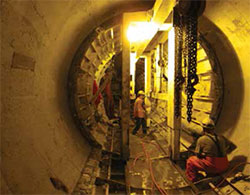One project Toronto’s public transit agency is doing to accommodate growth required building a new sewage tunnel. When the construction method proved agonizingly slow, GO Toronto managers specified one they’d never used to make up for lost time.
Initially, a variation of slip-forming and blind-side waterproofing was used. Formwork was de-molded and moved ahead on rails while crews applied waterproofing membrane for the next section. But unlike the continuous pouring that true slip-forming allows, each section was poured separately and allowed to harden before the formwork could be moved ahead for the next pour.
 For the second phase of construction, an admixture was used to simultaneously pour and waterproof.
For the second phase of construction, an admixture was used to simultaneously pour and waterproof.
Integral crystalline systems use available water to grow crystals inside concrete, effectively closing off pathways for damaging moisture and eliminating the extra step of applying a membrane ahead of the pour to resist hydrostatic pressure. The formula can allow concrete to self-seal hairline cracks up to 0.02 inches, doesn’t contain volatile organic compounds (VOCs), and can be completely recycled when demolition occurs.
Ultimately, 4,000 cubic yards of concrete with Krystol Internal Membrane (KIM), made by Kryton International Inc. of Vancouver, British Columbia, was placed. The company’s Krystol Waterstop System for joints was also used in both the tunnel and ventilation shafts.
Both are performing well.
Source: Public Works